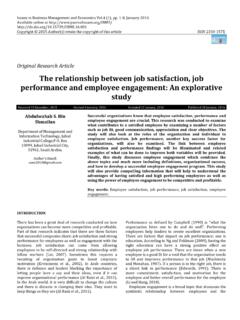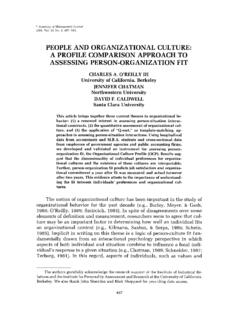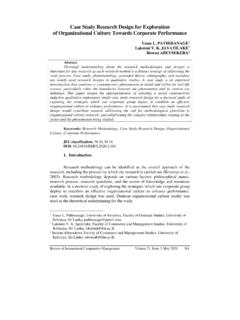Transcription of Organizational Culture Definition and Characteristics
1 Is Organizational Culture ? Organizational Culture is defined as the underlying beliefs, assumptions, values and ways of interacting that contribute to the unique social and psychological environment of an Culture Definition and CharacteristicsOrganizational Culture includes an organization s expectations, experiences, philosophy, as well as the values that guide member behavior, and is expressed in member self-image, inner workings, interactions with the outside world, and future expectations. Culture is based on shared attitudes, beliefs, customs, and written and unwritten rules that have been developed over time and are considered valid (The Business Dictionary). Culture also includes the organization s vision, values, norms, systems, symbols, language, assumptions, beliefs, and habits (Needle, 2004).Simply stated, Organizational Culture is the way things are done around here (Deal & Kennedy, 2000).
2 While the above definitions of Culture express how the construct plays out in the workplace, other definitions stress employee behavioral components, and how Organizational Culture directly influences the behaviors of employees within an this set of definitions, Organizational Culture is a set of shared assumptions that guide what happens in organizations by defining appropriate behavior for various situations (Ravasi & Schultz, 2006). Organizational Culture affects the way people and groups interact with each other, with clients, and with stakeholders. Also, Organizational Culture may influence how much employees identify with their organization (Schrodt, 2002).In business terms, other phrases are often used interchangeably, including corporate Culture , workplace Culture , and business Culture . How is Organizational Culture Created and Communicated?
3 Business leaders are vital to the creation and communication of their workplace Culture . However, the relationship between leadership and Culture is not one-sided. While leaders are the principal architects of Culture , an established Culture influences what kind of leadership is possible (Schein, 2010).Leaders must appreciate their role in maintaining or evolving an organization s Culture . A deeply embedded and established Culture illustrates how people should behave, which can help employees achieve their goals. This behavioral framework, in turn, ensures higher job satisfaction when an employee feels a leader is helping him or her complete a goal (Tsai, 2011). From this perspective, Organizational Culture , leadership, and job satisfaction are all inextricably can create, and also be created or influenced by, many different workplace cultures.
4 These differences can manifest themselves is a variety of ways including, but not limited to:Workplace Culture DifferencesPerson Culture and Market CultureHow members of an organization conduct business, treat employees, customers, and the wider community are strong aspects of person Culture and market Culture . Person Culture is a Culture in which horizontal structures are most applicable. Each individual is seen as more valuable than the organization itself. This can be difficult to sustain, as the organization may suffer due to competing people and priorities (Boundless, 2015). Market cultures are results-oriented, with a focus on competition, achievement, and getting the job done (ArtsFWD, 2013).Adaptive Culture and Adhocracy CultureThe extent to which freedom is allowed in decision making, developing new ideas and personal expression are vital parts of adaptive cultures and adhocracy cultures.
5 Adaptive cultures value change and are action-oriented, increasing the likelihood of survival through time (Costanza et al., 2015). Adhocracy cultures are dynamic and entrepreneurial, with a focus on risk-taking, innovation, and doing things first (ArtsFWD, 2013).Power Culture , Role Culture , and Hierarchy CultureHow power and information flow through the Organizational hierarchy and system are aspects of power cultures, role cultures, and hierarchy cultures. Power cultures have one leader who makes rapid decisions and controls the strategy. This type of Culture requires a strong deference to the leader in charge (Boundless, 2015). Role cultures are where functional structures are created, where individuals know their jobs, report to their superiors, and value efficiency and accuracy above all else (Boundless, 2015).
6 Hierarchy cultures are similar to role cultures, in that they are highly structured. They focus on efficiency, stability, and doing things right (ArtsFWD, 2013).Task Culture and Clan CultureHow committed employees are towards collective objectives are parts of task cultures and clan cultures. In a task Culture , teams are formed with expert members to solve particular problems. A matrix structure is common in this type of Culture , due to task importance and the number of small teams in play (Boundless, 2015). Clan cultures are family-like, with a focus on mentoring, nurturing, and doing things together (ArtsFWD, 2013).How and Why Does Organizational Culture Change? Organizational Culture is not stagnant. Members of an organization develop a shared belief around what right looks like as they interact over time and learn what yields success and what doesn t.
7 When those beliefs and assumptions lead to less than successful results, the Culture must evolve for the organization to stay relevant in a changing Organizational Culture is not an easy undertaking. Employees often resist change and can rally against a new Culture . Thus, it is the duty of leaders to convince their employees of the benefits of change and show through collective experience with new behaviors that the new Culture is the best way to operate to yield & Worley (2004) proposed six guidelines for Culture & Worley Six Guidelines for Culture Change1. Formulate a clear strategic vision. This vision gives the intention and direction for the future Culture Display top- management commitment. The top of the organization must favor the Culture change in order to actually implement the change in the rest of the Model Culture change at the highest level.
8 The behavior of the management needs to symbolize the kinds of values and behaviors that should be realized in the rest of the company. Change agents are keys to the success of this cultural change process and important communicators of new Modify the organization to support Organizational change. This includes identifying what current systems, policies, procedures and rules need to be changed so alignment with the new values and desired Culture can be Select and socialize newcomers and terminate deviants. Encouraging employee motivation and loyalty to the company will create a healthy Culture . Training should be provided to all employees to help them understand the new processes, expectations, and Develop ethical and legal sensitivity. This step can identify obstacles of change and resistant employees, and acknowledge and reward employee improvement, encouraging continued change and are Organizational SubCultures?
9 Rather than changing an entire organization s Culture , an organization can be adaptable and agile by allowing certain types of subcultures to emerge. Organizational subcultures are groups whose common characteristic is a shared norm or belief (Boisnier & Chatman, 2002).Subcultures are classified as enhancing, orthogonal, or counterculture, each exemplifying a different level of congruence with the dominant Culture s values (Martin & Siehl, 1983). Members of enhancing subcultures adhere to dominant Organizational Culture values even more enthusiastically than members of the rest of the organization. Members of orthogonal subcultures both embrace the dominant Culture s values and hold their own set of distinct, but not conflicting, values. Finally, members of a counterculture disagree with the core values of the dominant Culture and hold values that directly conflict with core Organizational having a deeply embedded Organizational Culture is usually associated with higher performance, these organizations may not be adaptive enough to ensure their long-term survival.
10 Organizations may, therefore, become more agile by allowing subcultures to there is widespread agreement that Organizational cultures do exist and that they are a key driver in shaping Organizational behaviors, pinpointing an exact Definition of the concept is a difficult absolute Definition would allow not only for a more rigorous study of Organizational Culture , but also increase our understanding of how it influences other Organizational outcomes such as productivity, employee engagement, and commitment. One thing is undoubtedly known about Culture : It is constantly being created, changed, and splintered to ensure the success of its parent organization. Cancialosi, C. (2017, July 17) What is Organizational Culture ? Retrieved from T. E. and Kennedy, A. A. (1982, 2000) Corporate Cultures: The Rites and Rituals of Corporate Life, Harmondsworth, Penguin Books, 1982; reissue Perseus Books, 2000 The Business Dictionary.







